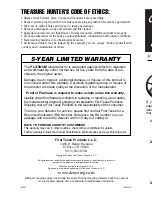
9
THE BASICS OF METAL DETECTING
A hobby metal detector is intended for locating buried metal objects.
When searching for metals, underground or on the surface, you have the
following challenges and objectives:
1. Ignoring signals caused by ground minerals.
2. Ignoring signals caused by metal objects that you do not want to
find, like pull-tabs.
3. Identifying a buried metal object before you dig it up.
4. Estimating the size and depth of objects, to facilitate digging them
up.
5. Eliminating the effects of electromagnetic interference from other
electronic devices.
Your PLATINUM metal detector is designed with these things in mind.
1. Ground Minerals
All soils contain minerals. Signals from ground minerals can interfere
with the signals from metal objects you want to find. All soils differ,
and can differ greatly, in the type and amount of ground minerals
present. You therefore want to “calibrate” the detector to the specific
ground conditions where you are hunting. The detector incorporates a
semi-automated ground-balancing feature which will eliminate false
signals from most types of soils. But if you want to maximize the
detector’s target identification accuracy and depth of detection, use the
GROUND GRAB function to calibrate the detector to the ground where
you are searching. See the section on GROUND GRAB for details.
2. Trash
If searching for coins, which will induce higher tone sounds, you want
to ignore items like aluminum foil, nails, and pull-tabs. These
undesirable items induce lower tones. You can listen to the sounds of
all objects detected, and decide on what you want to dig up. Or you
can eliminate unwanted metals from detection by using the
DISCRIMINATION feature.
3. Identifying Buried Objects
When searching in the DISCRIMINATION mode, different objects induce
different tones (high, medium, low) and are classified on the display
16
OPERATION and CONTROLS
cont.
MODE SELECTIONS
There are four selections under the MODE section of the display.
• Press
to toggle between DISCRIMINATION and ALL METALS.
• While operating in the DISCRIMINATION mode, press
to
activate PINPOINT mode.
• While operating in the ALL METALS mode, press
to activate
GROUND GRAB.
1. DISCRIMINATION Mode
This mode is the default mode, and requires the searchcoil to be in
motion in order to detect and identify targets. This is the mode most
commonly used for continuous searching. In this mode, targets are
identified with distinct tones, and are classified in categories at the top of
the display. A two-digit numerical value, on a scale of 10 to 99, is
displayed in the middle of the screen. The depth range of the target is
also displayed at the bottom of the display. All menu items can be
selected and customized in this mode.
2. ALL METALS Mode
This mode is a no-motion mode. Metal targets are detected with the
searchcoil motionless over the target. Target identification is not possible
in this mode. All metal objects will induce a single monotone hum. The
2-digit value in the middle of the screen represents the approximate
target depth, in inches. Only the SENSITIVITY and VOLUME menu items
are adjustable in this mode.
The ALL METALS mode requires periodic retuning using the
button. The sensitivity will drift over time. If sensitivity drifts upward, the
detector will sound off spontaneously. If sensitivity drifts downward, the
detector will become less sensitivity without any obvious indication to
the user. Upward drift is the norm, and can be quickly resolved by
pressing
momentarily. Do not hold
down as this will cause
the detector to enter the Ground Grab mode. Drift is exacerbated by
temperature change. If moving from a cool environment (e.g. indoor air
conditioning) to a hot (e.g. summer day outside) environment, upward
drift will occur very quickly. After the coil temperature has stabilized
(about 20 minutes), drift time will return to normal.









































